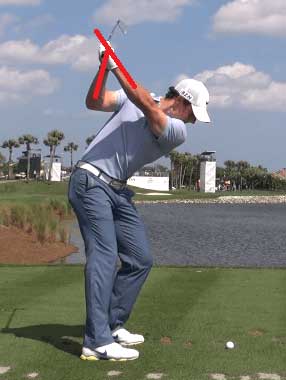COMMON DENOMINATORS – The Backswing
By Greg Schulze
Last issue I described the common denominators of the set-up. This is about the backswing. Have you ever watched the golf professionals on TV and thought, “They make it look so easy, yet powerful”? What makes it “easy?” What is it that we find so appealing? Could it be that “easy” swings simply activate the minimal amounts of required motions, without sacrificing any accuracy or distance? To use an old adage, do they work “SMARTER NOT HARDER?”
Can we conclude that there must be some link between the “pretty” swings and those few “ugly” swings on TV since both styles can shoot successful scores on the same golf course during the same tournament? Do the “make-it-look-easy” swings CHANGE a lot from set-up to finish or do they MAINTAIN a lot? It is my contention that (by logical definition), both efficiency and consistency fall under the MAINTAIN AS MUCH AS YOU CAN AND ONLY CHANGE WHAT IS NEEDED logic.
During those periods of poor golf performance, perhaps when most “desperate”, you may become susceptible to believing that there must be some void, some missing skill which can only be filled through more practice, more fixing, more lessons, more golf magazines, watching more YouTube videos, etc. An assumption that your personal development must need something ADDED to move to your next level…Be careful! Could “ADDITION by SUBTRACTION” be the more logical path?
The COMMON DENOMINATORS of the set-up were covered in the last issue, this month it’s about the full-swing backswing.
MAINTAIN THESE BACKSWING ITEMS ESTABLISHED AT SET-UP:
- Lead arm maintains its original set-up length
- Side bend (the slight tilt of the upper body away from the target as seen from the front view)
- Upper body tilt (as seen from the down-the-line view)
- Trail knee flex
- Feet to ground connection
- Center of gravity (located approximately at tailbone)
- Swing center (located at upper sternum area)
CHANGE THESE BACKSWING ITEMS:
- Lead arm swings/stretches over trail shoulder
- Wrists hinging upward
- Trail elbow folding
- Big muscle coil
BACKSWING NOTES
- Did you notice that the MAINTENANCE list is longer than the CHANGE list, which is logical using the “work smarter, not harder” goal?
- Appreciate the irony that some portion of your development may require focus on areas of your backswing which should never have changed in the first place.
- Other body motions and positions do change, but they are EFFECTS (for example “weight shift” which occurs “within and while” you are coiling), they do not need to be in the conscious mind.
HOW YOU SHOULD USE THIS INFORMATION:
You DON’T have to follow the crowd! Be open-minded to a different, even a perceived counter-intuitive learning approach. I am convinced that the majority of complaints of “inconsistent” are due to either having too MANY “actors and not enough re-actors” in your swing and/or not having a clear understanding of actors vs. reactors. Accelerated development may be best pursued using ADDITION BY SUBTRACTION. Consider the possibility that most of the top players make it look easy not because they have ADDED more skills than you but have subtracted unnecessary motions. When you have a clear distinction between the MAINTAIN versus CHANGE lists, you will be ultra-productive every practice session… You’ll begin working SMARTER not HARDER!






























